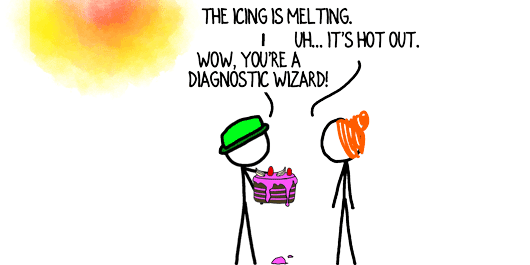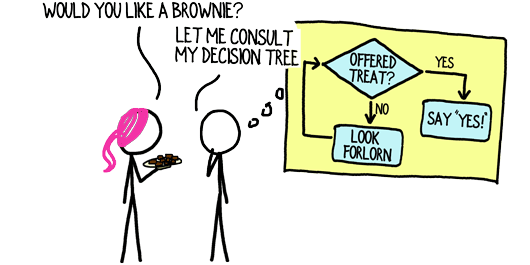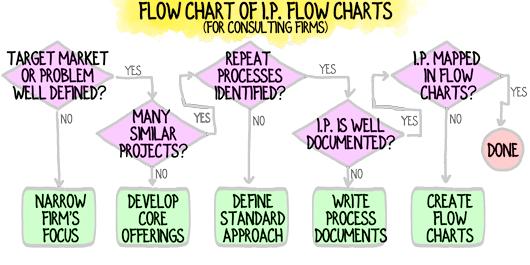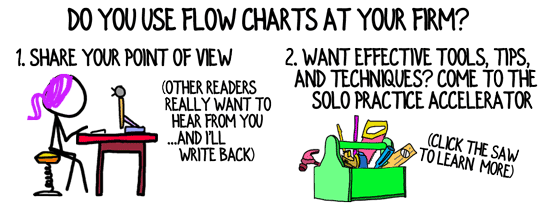You make decisions in the course of creating value for your consulting firm’s clients. That decision-making ability can be captured in a simple, powerful format that will reduce your labor intensity and, potentially, attract clients.
If your consulting firm assesses situations and dispenses advice (e.g., “Your cookies are too soft because the oven is overheated; cook longer at lower temperatures.”), then your diagnostic abilities are on display with your clients.
Even if your consulting firm’s engagements are oriented toward execution, you still encounter little conundrums along the way.
For instance, if you implement a sweet culture at bakeries, perhaps you determine which cultural principles are the highest priority for each pâtisserie. Or if you research the rugelach industry and report trends, you decide how to deal with aberrant data and which trends to convey.
By converting the problem-solving processes rattling around your team’s noggins into decision trees, you’ll create a portfolio of extraordinarily valuable assets for your consulting firm.
Decision trees are straightforward, simple-to-follow flow charts. To build yours, record the questions you ask to determine what’s going wrong at a client, or what actions you should recommend, or how to resolve common challenges that crop up in your consulting firm’s engagements.
Your efforts will produce a graphic that’s typically captured on a single page. It can be distributed internally, dressed up as an infographic for clients, printed on the lid of your holiday cookie-tin or, perhaps, easily sketched out as an instagraphic to impress prospects.
At a minimum, the flowchart will clarify your consulting firm’s “official” decision-making rationale for everyone in your firm—yielding a faster, more consistent path through challenges.
You’ll probably also develop a piece of IP that is absolutely indispensable for your clients. The type of IP that creates strong, positive feelings toward your firm and prompts them to recommend your firm to others.
Don’t worry that you’re giving away all your secrets when you hand your flow chart to clients.
Your consulting firm’s value lies beyond knowing what questions to ask and what steps to take.
Understanding how to apply those questions, how to interpret the results and, especially, how to implement the steps implied by the decision tree make your consulting firm a prized resource for prospective clients.
What is one, important, decision-making process your consulting firm utilizes that you could capture in a decision tree?
Text and images are © 2024 David A. Fields, all rights reserved.

 David A. Fields Consulting Group
David A. Fields Consulting Group 




Great article David A Fields. I’m going to think about which process is best to capture in a flow chart.
Outstanding, Lisa. A great starting point is the problem-solving process you probably use almost instinctively with your clients. When you speak to a client and quickly diagnose the likely issue or ask them a series of questions… that’s what you want to capture in your flow chart.
Thanks for the feedback and for kicking off the conversation, Lisa!
David, This article could only be more spot on if I knew how to use LucidSpark! My handwritten streams of consciousness don’t suffice.
Trow, your handwritten streams of consciousness absolutely suffice! You can use a combination of AI and real people (e.g., an inexpensive freelancer from Upwork) to turn your scrawls into decision trees. In fact, you’re far better off using your time to do the thinking and sketching than futzing around in flow charting software.
Thanks for setting up a soapbox for me to give a little speech about delegation. (Stepping down, now.) I appreciate your chiming in, Trow.
Wow! And thank you. This hit at exactly the right time for me. That is all 🙂
Three cheers for the right information at the right time, Troy! I appreciate your letting me know we hit the mark with this article.
Great article, as always. This is a great way to determine if there is this value when looking at partnering with potential clients.
Absolutely right, Shantana. Your internal decision-making process for determining whether or not to take on a client could be captured in a decision-tree and it would turn into a valuable asset for your firm.
Thank you for extending the idea and posting your thoughts, Shantana!
In Boston, the law firm, Caldwell IP is successfully obtaining patents for processes that are services. Their success rate for these patents is 96% and they complete them in 6-9 months. In essence, these patents are then assets and some companies like Aon, will use them as collateral for loans. Very exciting for those of us who have created unique processes. A patent will protect them and have them valued as assets.
That’s fascinating, Lynn. Off hand, I’d guess the utility of a patent (sorry for the pun) is fairly low for a small consulting firm.
I don’t think clients would work with a consulting firm simply because the firm claims their process is patented, and protecting the patent through expensive legal action would be unlikely to pay off. Wouldn’t it be a better use of a small firm’s resources to win more engagements and hire additional, value-creating staff? If there’s some technology supporting the business process, that strikes me as being more worthy of patenting.
Total speculation on my part, though. I’d love to hear examples of patents being valuable to small consulting firms. And, I very much appreciate the totally different line of thinking you’ve raised, Lynn!